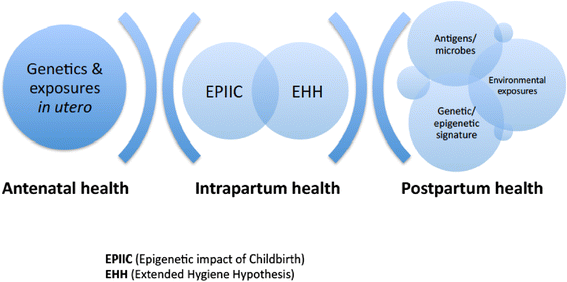Childbirth and consequent atopic disease: emerging evidence on epigenetic effects based on the hygiene and EPIIC hypotheses
- PMID: 26762406
- PMCID: PMC4712556
- DOI: 10.1186/s12884-015-0768-9
Childbirth and consequent atopic disease: emerging evidence on epigenetic effects based on the hygiene and EPIIC hypotheses
Abstract
Background: In most high and middle income countries across the world, at least 1:4 women give birth by cesarean section. Rates of labour induction and augmentation are rising steeply; and in some countries up to 50% of laboring women and newborns are given antibiotics. Governments and international agencies are increasingly concerned about the clinical, economic and psychosocial effects of these interventions.
Discussion: There is emerging evidence that certain intrapartum and early neonatal interventions might affect the neonatal immune response in the longer term, and perhaps trans-generationally. Two theories lead the debate in this area. Those aligned with the hygiene (or 'Old Friends') hypothesis have examined the effect of gut microbiome colonization secondary to mode of birth and intrapartum/neonatal pharmacological interventions on immune response and epigenetic phenomena. Those working with the EPIIC (Epigenetic Impact of Childbirth) hypothesis are concerned with the effects of eustress and dys-stress on the epigenome, secondary to mode of birth and labour interventions. This paper examines the current and emerging findings relating to childbirth and atopic/autoimmune disease from the perspective of both theories, and proposes an alliance of research effort. This is likely to accelerate the discovery of important findings arising from both approaches, and to maximize the timely understanding of the longer-term consequences of childbirth practices.
Figures
References
-
- Kitzinger S. Rediscovering Birth. London: Little Brown and Company; 2000.
-
- Jordan B. Birth in Four Cultures: a cross cultural investigation of childbirth in Yucantan, Holland, Sweden and the United States. Illinois: Waveland Press Inc.; 1993.
-
- Murphy-Lawless J. Reading Birth and Death: A History of Obstetric Thinking. Bloomington and Indianapolis: Indiana University Press; 1998.
-
- Renfrew MJ, Homer CSE, Downe S, McFadden A, Muir N, Prentice T, et al. The Lancet's Series on Midwifery Executive Summary. Lancet. 2014;2014:1–8.
-
- Van Lerberghe W, Matthews Z, Achadi E, Ancona C, Campbell J, Channon A, et al. Country experience with strengthening of health systems and deployment of midwives in countries with high maternal mortality. Lancet. 2014. - PubMed
MeSH terms
LinkOut - more resources
Full Text Sources
Other Literature Sources
Medical


